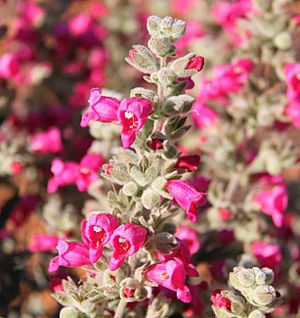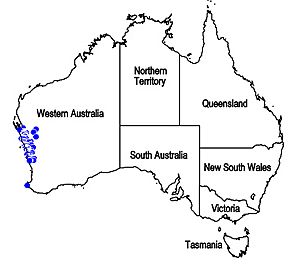Golden bush facts for kids
Quick facts for kids Golden bush |
|
|---|---|
 |
|
| Quoya verbascina growing near Mullewa | |
| Scientific classification | |
| Genus: |
Quoya (plant)
|
| Species: |
verbascina
|
 |
|
| Synonyms | |
Quoya verbascina, also known as golden bush, is a beautiful flowering plant from the mint family. It grows only in Western Australia. This plant is a tall shrub with branches and leaves covered in soft, woolly hairs. Its flowers are usually pinkish-white with pink spots inside. They are surrounded by yellow, woolly leaf-like parts called sepals.
Contents
What Does Golden Bush Look Like?
Golden bush is a tall shrub. Its main stem and branches are covered in thick, woolly hairs. These hairs can be dark brownish-red or pale brownish-yellow. They often make the top parts of the plant look yellowish.
The leaves of the golden bush are usually oval or oblong. However, their shape can vary a lot! They are mostly about 3 to 7 centimeters (1 to 3 inches) long. The leaves are thick, soft, and also covered in woolly hairs.
Golden Bush Flowers
The flowers grow in the upper parts of the plant, where the leaves meet the stem. They usually appear in groups of five to nine flowers. Each flower sits on a woolly stalk, about 3 to 10 millimeters (0.1 to 0.4 inches) long.
At the base of the flowers, there are small, woolly leaf-like structures called bracts. The five yellow sepals are 10 to 13 millimeters (0.4 to 0.5 inches) long. They join at the bottom to form a small tube. This tube is covered with woolly hairs on the outside.
The petals are pinkish-white with pink spots inside. There are five petals, about 12 to 18 millimeters (0.5 to 0.7 inches) long. They form a tube with a wide opening and five lobes (sections). The two top lobes are short and oblong. The two outer lower lobes are small and triangular. The middle lobe is much larger than the others.
The outside of the petal tube has short, soft hairs. Inside, it is smooth, except for a ring of hairs around the ovary. The four stamens (which produce pollen) are about as long as the petal tube. The upper two are shorter than the lower two.
Reproduction and Fruit
Golden bush usually flowers from July to December. After flowering, it produces fruit. The fruit is a curved oval shape, about 2.5 to 3 millimeters (0.1 inches) long. It is covered with soft hairs and still has the sepals attached.
How Golden Bush Got Its Name
This plant was first officially described in 1859. A scientist named Ferdinand von Mueller gave it the name Chloanthes verbascina. He published his description in a book called Fragmenta phytographiae Australiae. He studied a plant sample collected by Augustus Oldfield near the Murchison River.
Later, in 1870, another scientist, George Bentham, changed its name to Pityrodia verbascina. But in 2011, Barry Conn and Murray Henwood gave it its current name, Quoya verbascina. They published this change in a scientific journal called Australian Systematic Botany.
The second part of its name, verbascina, comes from a Latin word. It refers to a plant commonly known as "mullein".
Where Does Golden Bush Grow?
Golden bush mostly grows in areas with shrubs, or in a type of plant community called kwongan. You can often find it growing along the sides of roads.
It is mainly found between the towns of Carnarvon and Moora in Western Australia. It grows across several different natural regions, including the Avon Wheatbelt, Carnarvon, Geraldton Sandplains, Murchison, Swan Coastal Plain, and Yagoo areas.
Is Golden Bush Safe?
The Western Australian Government's Department of Parks and Wildlife has looked at the status of Quoya verbascina. They have classified it as "not threatened". This means the golden bush is not currently in danger of disappearing.

